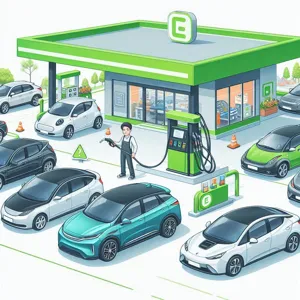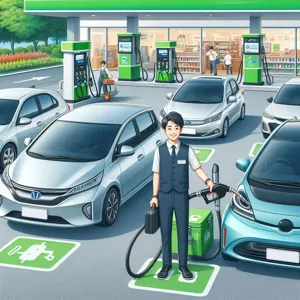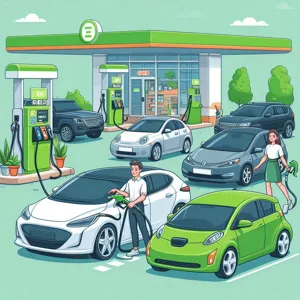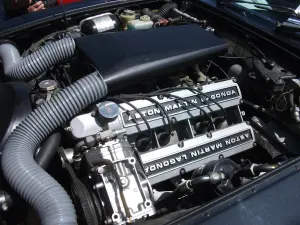In the bustling heartbeat of urban life, where traffic jams, tight parking spots, and crowded streets are part of the daily grind, having the right vehicle can make all the difference.
As cities continue to expand and evolve, so do the demands placed on our transportation choices. Whether you’re commuting to work, running errands, or exploring the vibrant cityscape, the perfect car should blend style, efficiency, and practicality. In this blog post, we’ll explore the top 10 cars that are ideally suited for navigating the complexities of urban living. From compact designs that effortlessly slip into tight parking spaces to eco-friendly options that help reduce your carbon footprint, these vehicles showcase innovative features and cutting-edge technology to enhance your city driving experience. Join us as we take a closer look at these urban warriors that promise to make your daily journeys smoother, more enjoyable, and undeniably stylish.
1. Introduction: The Importance of Choosing the Right Urban Car
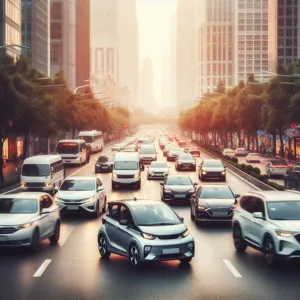
In the fast-paced world of urban living, the right car can make all the difference in your daily routine. With bustling streets, limited parking, and a variety of driving conditions, selecting a vehicle that suits the demands of city life is crucial. An ideal urban car should embody a blend of efficiency, compact design, and versatility, allowing you to navigate tight spaces and congested roads with ease.
Moreover, the urban environment often requires a vehicle that offers excellent fuel economy and eco-friendliness, as city dwellers increasingly prioritize sustainable options. Beyond practicality, the right urban car should also provide comfort and modern technology to enhance your driving experience, making commutes and errands less of a chore and more of a pleasure.
Whether you’re a first-time car buyer, a seasoned urbanite looking to upgrade, or simply considering the best options for city living, understanding the unique challenges of urban navigation will guide your decision-making process. In this blog post, we’ll explore the top 10 cars that not only meet these essential criteria but also elevate your urban driving experience. From agile hatchbacks to hybrid wonders, these vehicles are designed to thrive in the concrete jungle while keeping you stylish and connected. So buckle up as we dive into the best choices for navigating urban life!
2. Factors to Consider When Selecting a City Car
When it comes to selecting a city car, several key factors can greatly influence your decision and enhance your urban driving experience. First and foremost, size matters. In crowded city environments, compactness is crucial. A smaller vehicle not only makes navigating tight streets and squeezing into parking spots easier, but it also tends to be more fuel-efficient—an essential consideration when you’re frequently stopping and starting in traffic.
Next, think about maneuverability. A car with a tight turning radius and responsive handling will allow you to dart around obstacles and navigate congested intersections with ease. Look for vehicles that come equipped with features like parking sensors or rearview cameras, as these can significantly reduce the stress of parallel parking in busy areas.
Another important factor is fuel efficiency. In a city setting where gas stations may be less frequent, a car that sips fuel rather than guzzles it can save you both time and money. Hybrid or fully electric options might be worth considering as they not only save on fuel but also align with eco-friendly commuting practices.
Safety features are paramount, especially in urban environments where pedestrians and cyclists share the road. advanced driver-assistance systems (ADAS) such as automatic emergency braking, lane departure warnings, and blind-spot monitoring can provide you with peace of mind and enhance your driving experience.
Lastly, consider your lifestyle needs. Do you often find yourself carrying passengers or cargo? If so, look for vehicles with flexible configurations and ample storage space. Alternatively, if your city life revolves around solo commutes or short trips, a minimalist vehicle with fewer frills might be the ideal choice. By evaluating these factors, you can ensure that your chosen city car perfectly aligns with your urban lifestyle and enhances your daily travels.
3. Compact Cars: Perfect for Tight Spaces

When it comes to maneuvering through bustling city streets and squeezing into those notoriously tight parking spots, compact cars reign supreme. These pint-sized powerhouses are designed with urban living in mind, offering a blend of efficiency, agility, and style that makes them ideal companions for city dwellers.
Compact cars, typically defined as vehicles measuring less than 175 inches in length, come with a host of advantages that make them a favorite among city commuters. Their smaller size allows for exceptional handling, making it easy to dart in and out of traffic, while also providing the ability to navigate narrow streets and crowded environments with ease. Whether you’re navigating a busy downtown area or darting through side streets, these cars offer the responsiveness needed to tackle urban driving challenges.
Moreover, compact cars often boast impressive fuel efficiency, which means you’ll spend less time (and money) at the pump, allowing you to allocate more resources toward enjoying the vibrant city life. Many models also come equipped with smart technology features, such as parking assist, rearview cameras, and advanced navigation systems, making it even simpler to find your way around complex urban landscapes.
In addition to practicality, compact cars don’t skimp on style. They come in a variety of eye-catching designs, colors, and trims, ensuring that you can express your personality while navigating the concrete jungle. Brands like Mini, Honda, and Ford offer standout options that combine sleek aesthetics with functionality, proving that you don’t have to sacrifice style for convenience.
Ultimately, if you’re seeking a vehicle that can handle the rigors of urban life while providing comfort and efficiency, compact cars are the perfect solution. They are a smart investment for city inhabitants who want to make the most of their driving experience while effortlessly gliding through the hustle and bustle of urban living.
4. Electric Vehicles: Eco-Friendly Options for Urban Commuting
As urban landscapes continue to evolve, so too does the demand for vehicles that align with the modern commuter’s lifestyle. Electric vehicles (EVs) have emerged as the quintessential choice for navigating city life, offering a myriad of benefits that extend beyond mere transportation. With their sleek designs, whisper-quiet operation, and zero tailpipe emissions, EVs are not only eco-friendly but also perfectly tailored to the hustle and bustle of urban environments.
First and foremost, electric vehicles provide an environmentally conscious alternative to traditional combustion engines. With concerns about air quality and climate change pressing more than ever, driving an EV allows city dwellers to significantly reduce their carbon footprint. Many municipalities are also incentivizing the use of electric cars through tax breaks and rebates, making them an even more attractive option for urban commuters.
In addition to their green credentials, electric vehicles are equipped with advanced technologies that enhance the driving experience. Features such as regenerative braking, which captures energy during deceleration, contribute to higher efficiency and extended range—key factors for city driving where stop-and-go traffic is the norm. Many EVs also come with smart connectivity options, allowing drivers to easily integrate their devices for navigation, music, and more, ensuring a smooth and enjoyable ride.
Parking is another crucial aspect of urban living where electric vehicles shine. Many cities are increasing the availability of charging stations, often located in prime parking spots. This means that EV owners can charge their cars while they go about their daily activities, eliminating the range anxiety that can accompany electric driving.
Moreover, electric vehicles tend to have lower operating costs compared to their gasoline counterparts. With fewer moving parts, reduced maintenance needs, and the lower cost of electricity versus gasoline, drivers can save significantly over time. This economical advantage, paired with the modern conveniences of EV technology, makes them an ideal choice for today’s urban commuter.
In summary, electric vehicles are not just a trend; they are a practical and eco-friendly solution for navigating urban life. As cities embrace sustainability and technology, choosing an EV is a step toward a greener future while enjoying the benefits of a versatile and efficient mode of transportation. Whether you’re zipping through city streets or finding parking in crowded neighborhoods, an electric vehicle is a smart investment for the urban lifestyle.
5. Hybrids: Balancing Efficiency and Performance

In the bustling realm of urban life, where stop-and-go traffic and tight parking spaces are the norm, hybrids are quickly becoming the go-to choice for the savvy city driver. These vehicles artfully balance efficiency and performance, making them a smart option for those who navigate the concrete jungle daily.
Hybrids, blending an internal combustion engine with an electric motor, are designed to optimize fuel consumption while still delivering a satisfying driving experience. As you glide through city streets, you’ll appreciate their ability to seamlessly switch between power sources, providing you with the best of both worlds. When you accelerate from a stoplight, the electric motor kicks in to offer instant torque, allowing for quick getaways without guzzling gas.
Moreover, their compact designs and advanced engineering make hybrids particularly adept at maneuvering through tight spaces and heavy traffic. Many models come equipped with features that enhance the driving experience, such as regenerative braking that captures energy during stops, further extending your range and reducing your carbon footprint.
In urban environments where parking can be a challenge, hybrids often feature smart, space-saving designs that fit easily into smaller spots. Additionally, many cities are implementing incentives for hybrid owners, such as reduced fees for parking or access to carpool lanes, making these vehicles even more appealing.
Whether you choose the sleek Toyota Prius, the sporty Honda Insight, or the stylish Lexus NX Hybrid, opting for a hybrid vehicle not only aligns with eco-friendly values but also enhances your urban driving experience. As you navigate through the hustle and bustle, you’ll find that these cars are not just a mode of transportation; they are partners in your urban adventure, effortlessly combining efficiency with performance.
6. Subcompact SUVs: Versatility in the City
Subcompact SUVs have carved out a unique niche in the urban automotive landscape, offering the perfect balance of versatility, style, and practicality. As cities become more congested and parking spaces more limited, these compact powerhouses are designed to navigate tight streets while still providing ample room for passengers and cargo.
One of the standout features of subcompact SUVs is their elevated driving position, giving drivers a better view of the road and surroundings—a crucial advantage in busy urban environments. Models like the Honda HR-V and Mazda CX-30 boast agile handling and responsive steering, making them a joy to drive in stop-and-go traffic. Their compact size allows for easy maneuverability around corners and through narrow alleys, effortlessly tackling the challenges of city driving.
Inside, subcompact SUVs surprise with their spacious interiors and clever storage solutions. Most models offer a flexible seating arrangement and a generous cargo area, perfect for hauling groceries, sports equipment, or even weekend getaway luggage. Additionally, many come equipped with modern technology and infotainment systems, keeping you connected and entertained during your daily commute.
Fuel efficiency is another strong point for subcompact SUVs, making them economical choices for city dwellers who may face high fuel costs. The combination of a smaller engine and lightweight design allows these vehicles to sip fuel rather than guzzle it, while still providing enough power for city and highway driving alike.
With their versatile nature, subcompact SUVs are equally suited for weekend adventures or weekday errands, making them an attractive choice for urbanites who lead dynamic lives. Whether you’re navigating through rush hour traffic or exploring new parts of the city, a subcompact SUV ensures you do it in comfort and style.
7. Sedans: Classic Choices for Urban Driving

When it comes to navigating the bustling streets of the city, sedans stand out as classic choices that marry practicality with style. These sleek vehicles are designed for urban environments, offering the perfect blend of compactness and comfort, making them ideal for both tight parking situations and long commutes.
Sedans typically feature a low profile and streamlined body, which not only enhances their aerodynamic efficiency but also makes them easy to maneuver through congested traffic. With their four-door layout, they provide ample passenger space without sacrificing the ability to slip into those small parking spots that are often the bane of city dwellers.
One of the key advantages of sedans is their fuel efficiency. Many modern sedans are equipped with advanced engines that deliver impressive mileage, helping you save money at the pump—an essential consideration for urban living where fuel costs can add up. Additionally, sedans tend to offer a smooth ride, absorbing the bumps and imperfections of city roads, which can make daily driving more enjoyable.
From the stylish lines of a compact sedan to the more spacious offerings that accommodate families, there is a sedan for every urban driver. Brands like Honda, Toyota, and Ford have long been trusted for their reliability and resale value, making them smart investments for those navigating city life.
In summary, sedans are not just vehicles; they are companions that simplify the complexities of urban driving. With their efficient design, comfort, and versatility, they remain a steadfast choice for anyone looking to thrive in the city landscape. Whether you’re zipping to work, running errands, or heading out for a night on the town, a sedan is always a smart option for urban adventurers.
8. The Rise of City-Friendly Crossovers
As urban life evolves, so too do the vehicles designed to navigate its complexities. Enter the rise of city-friendly crossovers—versatile, compact, and perfectly tailored for the demands of city driving. These vehicles bridge the gap between functionality and style, making them increasingly popular among city dwellers, young professionals, and families alike.
What sets city-friendly crossovers apart is their ability to combine the advantages of an SUV with the agility of a smaller car. With a higher driving position, these vehicles offer better visibility, helping drivers navigate through crowded streets and tight corners with ease. Their compact dimensions mean they can squeeze into those elusive parking spots, a must-have feature for anyone living in a bustling metropolis.
Moreover, these crossovers are designed with urban living in mind, boasting efficient fuel economy and eco-friendly options that appeal to the environmentally conscious driver. Many models come equipped with advanced technology, such as integrated navigation systems and smart connectivity features, ensuring you stay updated on traffic conditions and the best routes to take.
The interior of city-friendly crossovers is often spacious and adaptable, providing ample room for both passengers and cargo. With the ability to reconfigure seats and storage areas, these vehicles can easily accommodate everything from a weekend getaway to a trip to the local farmer’s market.
As cities continue to expand and traffic congestion becomes commonplace, the allure of city-friendly crossovers will only grow. They represent a practical solution for those seeking a balance between comfort, style, and maneuverability in an urban landscape. Whether you’re commuting to work, running errands, or exploring new neighborhoods, these crossovers offer the perfect blend of versatility and convenience, making them an ideal choice for navigating urban life.
9. Features to Look for in an Urban Car
When selecting the perfect urban car, understanding the unique demands of city driving is crucial. The ideal vehicle should seamlessly blend practicality with comfort, ensuring you can navigate bustling streets, tight parking spots, and unpredictable traffic with ease. Here are some essential features to consider:
1. **Compact Size**: A smaller footprint is key for maneuverability. Look for cars that are easy to park and can slip into those narrow gaps that are often the only options in crowded areas.
2. **Fuel Efficiency**: With stop-and-go traffic being a common scenario in urban settings, fuel-efficient vehicles can save you money and reduce your environmental footprint. Consider hybrids or smaller engines that deliver excellent mileage.
3. **Advanced Safety Features**: Urban driving poses unique challenges, from pedestrians darting across the street to cyclists weaving in and out of traffic. Features such as automatic emergency braking, pedestrian detection, and lane-keeping assist can enhance your safety and confidence on the road.
4. **Technology Integration**: In a fast-paced urban environment, connectivity is key. Look for cars equipped with user-friendly infotainment systems that support smartphone integration, allowing you to access navigation apps, music, and hands-free communication effortlessly.
5. **Comfortable Interior**: City driving can often mean longer periods spent in your vehicle due to traffic delays. Comfortable seating, good climate control, and ample cargo space for groceries or bags can make your daily commute much more enjoyable.
6. **Tight Turning Radius**: A vehicle that can turn sharply will help you navigate tight corners and narrow streets with ease. Test drive potential options to gauge how easily they handle in urban environments.
7. **Durability and Reliability**: Urban environments can be tough on cars, with potholes, rough roads, and frequent stops putting extra wear on your vehicle. Choose a make and model known for its reliability and durability to minimize maintenance issues down the line.
8. **Parking Assistance**: Many new cars come equipped with parking sensors and rear-view cameras, which can be incredibly helpful in tight urban spaces. Some even offer automated parking features that can parallel park for you—an invaluable asset in a bustling city.
By keeping these features in mind, you can select a vehicle that not only meets your needs but also enhances your urban driving experience, making every journey more enjoyable and less stressful. Whether you’re commuting to work, running errands, or exploring the city, the right car can make all the difference.
10. Safety Ratings: Protecting Yourself in Busy Environments
When it comes to navigating the bustling streets of the city, safety should always be a top priority. Urban environments can be unpredictable, with a constant flow of pedestrians, cyclists, and other vehicles, making it crucial to choose a car that excels in safety ratings. Understanding these ratings can provide peace of mind and ensure you’re well-equipped to handle the challenges of city driving.
Cars that score high on safety tests are designed with advanced features that help protect both the driver and passengers. Look for vehicles equipped with essential safety technologies such as automatic emergency braking, lane departure warning, adaptive cruise control, and blind-spot monitoring. These features not only enhance your ability to respond to sudden hazards but also significantly lower the risk of accidents in crowded settings.
Additionally, many urban-friendly cars come with impressive crash-test ratings from organizations such as the National Highway Traffic Safety Administration (NHTSA) and the Insurance Institute for Highway Safety (IIHS). These ratings consider various factors, including the structural integrity of the vehicle and the effectiveness of safety technologies in preventing collisions. A car that consistently receives high marks in these evaluations is your best bet for navigating busy streets with confidence.
Moreover, compact cars and crossovers are often designed with a smaller footprint, making them easier to maneuver through tight spaces and congested traffic. However, don’t let size fool you; many of these vehicles are built with robust safety structures and high-tech features that prioritize protection in urban settings.
In summary, when selecting a car for urban life, prioritize safety ratings to ensure that you are not only navigating the city efficiently but also protecting yourself and your passengers. With the right vehicle, you can tackle the challenges of urban driving while feeling secure and in control.
11. Fuel Efficiency: Saving Money in the City
In the bustling urban landscape, where stop-and-go traffic can turn a simple commute into a time-consuming ordeal, fuel efficiency emerges as a key consideration for city dwellers. Not only does a car with great fuel economy help you save money at the pump, but it also minimizes your carbon footprint—an increasingly important factor for environmentally conscious drivers.
Imagine zipping through crowded streets without the nagging worry of frequent fill-ups. A fuel-efficient vehicle allows you to stretch your dollars further, making it an ideal companion for navigating the often unpredictable demands of urban life. Whether you’re running errands, commuting to work, or enjoying a weekend adventure, the right car can make all the difference.
For city driving, compact cars and hybrids often come out on top, offering impressive miles per gallon while still delivering the maneuverability needed to weave through tight spaces. Think of models that prioritize efficiency, such as subcompacts that are lightweight and agile, allowing you to dart in and out of traffic with ease. Additionally, hybrids bring the best of both worlds—electric power for short trips and gasoline for longer excursions—ensuring you won’t find yourself stranded in a congested area with a dead battery.
As you explore your options, consider vehicles equipped with advanced technology that enhances fuel economy. Features like regenerative braking, eco-driving modes, and even real-time feedback on your driving habits can contribute to better mileage and lower fuel costs. By choosing a car that excels in fuel efficiency, you’ll not only save money but also enjoy a more convenient, stress-free urban driving experience.
12. Top 10 Cars for Urban Living: A Countdown
When it comes to urban living, the right car can make all the difference in navigating the bustling streets, tight parking spots, and public transport challenges. The perfect urban vehicle combines compact size, fuel efficiency, and a touch of style to help you conquer city life with ease. Here’s our countdown of the top 10 cars that are perfectly tailored for urban environments, ensuring you can zip around town effortlessly while also turning heads along the way.
**10. Honda Fit**
Compact yet surprisingly spacious, the Honda Fit excels in urban settings. Its versatile Magic Seat allows for multiple cargo configurations, making it ideal for spontaneous trips to the farmer’s market or weekend getaways. Plus, with excellent fuel economy, you can stretch your budget further.
**9. Mini Cooper**
The Mini Cooper is the epitome of fun and funky design, perfect for the urban dweller who wants to stand out. Its small footprint makes parking a breeze, while responsive handling gives you the agility needed to navigate busy streets. With a variety of customizations available, each Mini can reflect your unique personality.
**8. Toyota Prius**
As one of the most recognizable hybrids on the market, the Toyota Prius is synonymous with eco-conscious urban living. Its impressive fuel efficiency means fewer stops at the pump and a smaller carbon footprint, allowing you to explore the city without guilt. Plus, the spacious cabin makes it perfect for friends and gear.
**7. Nissan Leaf**
The Nissan Leaf represents the forefront of electric vehicles designed for urban use. With zero emissions and a quiet ride, it’s perfect for city dwellers who value sustainability. The Leaf’s compact shape and advanced technology make it easy to maneuver through crowded streets, while the ample interior space ensures you don’t sacrifice comfort.
**6. Ford Fiesta**
A classic choice for city driving, the Ford Fiesta offers a spirited driving experience in a small package. With its nimble handling and efficient engine, this hatchback is perfect for darting in and out of traffic and finding parking in the tightest of spots. Its stylish design and tech-savvy features make it a favorite among young professionals.
**5. Hyundai Kona**
The Hyundai Kona blends the best of both worlds with its compact SUV design. This car provides higher ground clearance without sacrificing the convenience of a smaller vehicle. With ample cargo space and modern safety features, the Kona is well-suited for urban adventures while keeping you safe and connected.
**4. Mazda CX-30**
The Mazda CX-30 is a stylish subcompact SUV that stands out in the urban jungle. With a premium interior and responsive performance, this vehicle offers a sophisticated driving experience. It’s perfect for those who want a bit more versatility without compromising on style or agility.
**3. Chevrolet Spark**
The Chevrolet Spark is one of the most affordable cars on the market, making it a perfect option for budget-conscious city dwellers. Its pint-sized design allows for easy maneuvering and parking, while its surprising tech features ensure you stay connected wherever you go.
**2. Volkswagen Golf**
The Volkswagen Golf has long been a favorite for urban living. Its blend of practicality and performance is hard to beat. With a spacious interior that doesn’t feel cramped, the Golf offers a comfortable ride for both driver and passengers. Plus, its hatchback design provides excellent cargo flexibility for those spontaneous shopping trips.
**1. Smart Fortwo**
Taking the top spot is the Smart Fortwo, a true icon of
13. Conclusion: Finding Your Ideal Urban Vehicle
Navigating the bustling streets of a city can be both exhilarating and challenging, and selecting the right vehicle to accompany you on this journey is crucial. As we’ve explored throughout this post, the perfect urban car is more than just a mode of transportation; it’s a companion that should enhance your daily life.
Consider factors such as size, fuel efficiency, and technology features, as these elements play a significant role in urban driving. Compact cars often shine in crowded environments, allowing for easy maneuverability and parking in tight spaces. Electric and hybrid options not only reduce your carbon footprint but also help you save on fuel costs, making them an attractive choice for eco-conscious drivers.
Moreover, the importance of connectivity cannot be overstated in today’s fast-paced world. Look for vehicles equipped with the latest tech—think sleek infotainment systems, smartphone integration, and advanced safety features—that keep you connected and secure as you navigate the urban jungle.
Ultimately, the ideal urban vehicle should reflect your lifestyle and priorities, whether you prioritize style, sustainability, or practicality. Take the time to assess your needs and preferences, and remember that the right car can transform your urban experience, turning everyday commutes into enjoyable adventures. As you embark on this search, keep in mind that the perfect car is out there, waiting to make city life just a little bit easier and a lot more enjoyable. Happy driving!
14. Tips for Maintaining Your Car in an Urban Environment
Maintaining your car in an urban environment can be quite the challenge, but with a few proactive strategies, you can ensure your vehicle remains in top shape amidst the hustle and bustle of city life. The constant stop-and-go traffic, pothole-ridden streets, and the potential for parking dings can take a toll on your car, but staying vigilant can help mitigate these effects.
**1. Regular Inspections:** Urban roads can be unforgiving, so make it a habit to conduct regular inspections. Check your tires for wear and tear more frequently, as city driving often leads to more frequent encounters with curbs and debris. Ensure your brakes are responsive, especially since city driving involves frequent stops.
**2. Keep it Clean:** City environments can be grimy, with dirt, grime, and pollutants accumulating on your vehicle. Regular washes not only keep your car looking sharp, but they also protect the paint and prevent rust, especially in areas where road salt is used during winter months. Don’t forget to clean the undercarriage, as it’s prone to corrosion from salt and grime.
**3. Pay Attention to Parking:** Finding parking can feel like a sport in urban areas, which often leads to tight spaces and careless drivers. To avoid dings and scratches, consider investing in parking sensors or a rearview camera if your car doesn’t have one. Always park in well-lit areas to deter vandalism and theft.
**4. Monitor Fluid Levels:** With the constant stop-and-go and varied driving conditions, your car’s fluids can deplete faster than you might expect. Regularly check your oil, coolant, and brake fluid levels to ensure your vehicle runs smoothly. Urban driving can increase engine heat, making it even more crucial to keep an eye on your coolant levels.
**5. Stay Ahead of Maintenance:** Urban driving can accelerate wear on various car parts. Adhere to your vehicle’s maintenance schedule, but also be proactive. If you notice unusual sounds or the check engine light comes on, address these issues promptly to avoid more significant problems down the line.
By implementing these tips, you can navigate the urban landscape with confidence, ensuring that your car remains reliable and efficient. A well-maintained vehicle not only enhances your driving experience but also contributes to the longevity of your car, making urban life just a bit easier to handle.
15. Final Thoughts on Navigating Urban Life with the Right Vehicle
Navigating the bustling streets of a city demands more than just a set of wheels; it requires a vehicle that can seamlessly merge practicality with style. As we’ve explored the top 10 cars ideal for urban life, it’s essential to recognize how the right vehicle can significantly enhance your daily experience. Whether you’re maneuvering through tight parking spots, zipping past rush-hour traffic, or simply seeking a comfortable ride for weekend getaways, the right car can make all the difference.
In the urban jungle, compactness is key. Smaller vehicles offer the agility needed to navigate crowded streets while providing exceptional fuel efficiency—a crucial consideration in a city where gas prices can be steep, and traffic can be relentless. Features like advanced safety systems, responsive handling, and state-of-the-art tech can transform your daily commute from a chore into a pleasure. Furthermore, many urban-friendly cars now come equipped with smart connectivity options, allowing you to stay in touch and entertained, even in the midst of the busiest city life.
But the choice extends beyond just functionality; aesthetics play a significant role as well. A stylish car not only reflects your personality but also makes a statement as you glide through the city. From chic hatchbacks to sleek sedans, urban vehicles are available in a myriad of designs, ensuring you find one that resonates with your lifestyle.
Ultimately, the right car isn’t merely about getting from point A to point B; it’s about enhancing your urban experience. By choosing a vehicle that meets your needs—be it efficiency, style, or tech prowess—you’ll find yourself better equipped to tackle the challenges of city living. So, as you embark on your journey through the concrete landscapes, remember that the perfect vehicle is not just a mode of transport, but a companion that will elevate your daily adventures in urban life.
In conclusion, navigating the bustling streets of the city requires a vehicle that combines practicality, efficiency, and style. The top 10 cars we’ve explored in this post are all excellent choices for urban life, offering features like compact designs, impressive fuel economy, and advanced technology to keep you connected on the go. Whether you prioritize maneuverability in tight spaces or the latest safety features, there’s a perfect fit for every city dweller. As you embark on your car-buying journey, remember that the right vehicle can enhance not just your daily commute but your overall urban experience. Happy driving, and may your new wheels make every city adventure a breeze!

